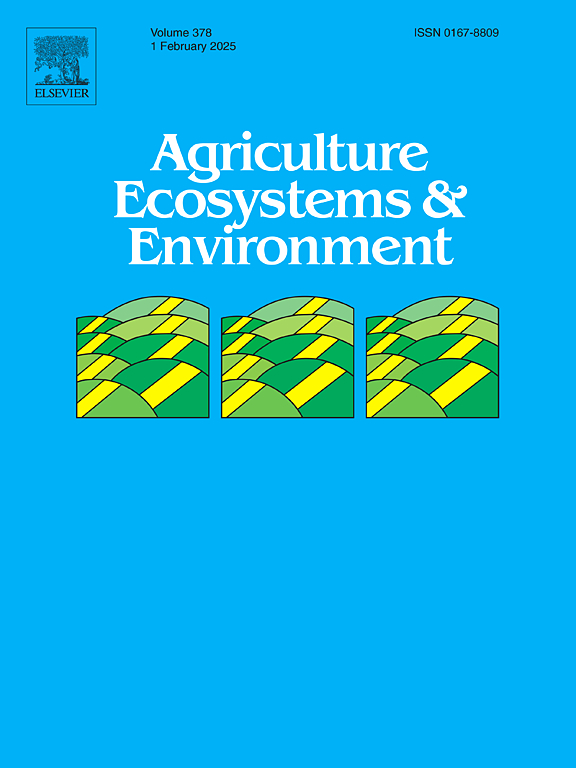Grazing disturbance reduces biocrust-related cyanobacteria and N-fixer abundance but increases bacterial diversity: Implications for biocrust restoration in degraded drylands
IF 6
1区 农林科学
Q1 AGRICULTURE, MULTIDISCIPLINARY
引用次数: 0
Abstract
Overgrazing is a major driver of dryland degradation, however, so far, there is limited understanding on how this process affects biocrust-related microbial community, and especially how the key groups respond to grazing disturbance. In this study, quantitative polymerase chain reaction (qPCR) and high throughout sequencing technologies were used to investigate the bacterial community abundance and diversity in the Horqin Sandland (China) experiencing different livestock grazing disturbances, in order to examine whether a shift in bacterial community (in particular the key biocrust components, cyanobacteria) was involved, and how this was related to biocrust development and altered soil carbon and nitrogen level. Our results revealed that a clear heterogeneous soil bacterial community was associated with grazing disturbance, which inhibited biocrust development. The decreased photosynthetic cyanobacterial abundance (81.81 % in relative abundance and 98.83 % in absolute abundance) and nitrogen-fixing genes (87.72 %), associated with the lower total carbon and nitrogen content (P<0.05), illustrated a low soil carbon and nitrogen-fixing capability and nutrient level in the grazing-disturbed soils. In particular, a switch of nitrogen-fixing dominance from cyanobacteria to proteobacteria was induced by the grazing disturbance. Compared to the grazing-disturbed soils, higher dominant cyanobacterial operational taxonomic units (OTUs) (especially the species of Nostoc and Scytonema) and lower bacterial diversity (e.g., Shannon, Ace, and Chao index) were observed in the undisturbed biocrust soils, highlighting that the dominants rather than diversity played more important roles in biocrust development. Collectively, our results demonstrate that cyanobacteria are very sensitive (even more than others, e.g., proteobacteria and actinobacteria) to grazing disturbance, therefore, we propose that cyanobacterial inoculation is likely an effective approach to supplement soil cyanobacterial abundance, which is expected to induce biocrust development and increase carbon and nitrogen level in the disturbed drylands.
放牧干扰减少了生物簇相关蓝藻和固氮菌的数量,但增加了细菌的多样性:对退化旱地生物群落恢复的影响
过度放牧是旱地退化的一个主要驱动因素,但迄今为止,人们对这一过程如何影响与生物壳相关的微生物群落,尤其是关键群落如何应对放牧干扰的了解还很有限。本研究采用定量聚合酶链式反应(qPCR)和高通量测序技术,对遭受不同放牧干扰的科尔沁沙地(中国)的细菌群落丰度和多样性进行了研究,以探讨细菌群落(尤其是生物簇的关键成分蓝藻)是否发生了变化,以及这种变化与生物簇的发展和土壤碳氮水平的改变有何关系。我们的研究结果表明,明显的异质性土壤细菌群落与放牧干扰有关,放牧干扰抑制了生物簇的发展。光合蓝藻丰度(相对丰度为 81.81%,绝对丰度为 98.83%)和固氮基因(87.72%)的降低与土壤总碳氮含量的降低(P<0.05)有关,说明放牧干扰土壤的固碳、固氮能力和养分水平较低。特别是,放牧干扰诱导了固氮优势菌从蓝藻向蛋白菌的转变。与放牧干扰土壤相比,未受干扰的生物簇土壤中蓝藻优势分类单元(OTUs)较高(尤其是Nostoc和Scytonema物种),细菌多样性(如Shannon指数、Ace指数和Chao指数)较低,这表明在生物簇发育过程中,优势菌比多样性发挥着更重要的作用。总之,我们的研究结果表明,蓝藻对放牧干扰非常敏感(甚至比蛋白细菌和放线菌等其他细菌更敏感),因此,我们建议蓝藻接种可能是补充土壤蓝藻丰度的一种有效方法,有望诱导生物簇发育并提高受干扰旱地的碳氮水平。
本文章由计算机程序翻译,如有差异,请以英文原文为准。
求助全文
约1分钟内获得全文
求助全文
来源期刊

Agriculture, Ecosystems & Environment
环境科学-环境科学
CiteScore
11.70
自引率
9.10%
发文量
392
审稿时长
26 days
期刊介绍:
Agriculture, Ecosystems and Environment publishes scientific articles dealing with the interface between agroecosystems and the natural environment, specifically how agriculture influences the environment and how changes in that environment impact agroecosystems. Preference is given to papers from experimental and observational research at the field, system or landscape level, from studies that enhance our understanding of processes using data-based biophysical modelling, and papers that bridge scientific disciplines and integrate knowledge. All papers should be placed in an international or wide comparative context.
 求助内容:
求助内容: 应助结果提醒方式:
应助结果提醒方式:


